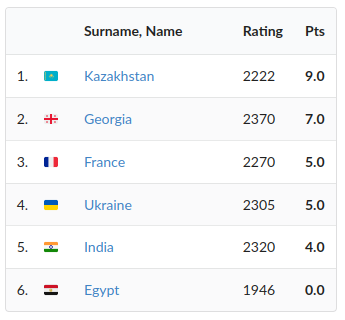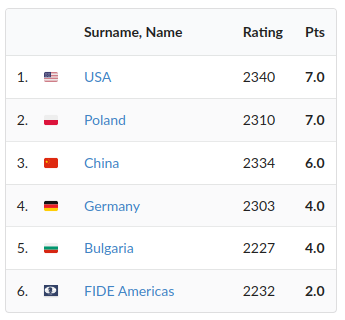Pool A: India cannot make it through
The last round of the pool stage was full of unexpected twits and turns at the World Women’s Team Championship, as seven teams still had chances to qualify for the knockout stage.
In Pool A, the clash between Kazakhstan and Georgia (2-2) seemed like a trivial affair, as both teams had already earned their spot in the knockout. However, the match turned out to be quite hard-fought, with all four games ending with a decisive result.
In a slightly inferior position with black against Bella Khotenashvili, Bibisara Assaubayeva opted for a bold exchange sacrifice that was objectively incorrect. However, the move paid off eventually, as Bella was in time trouble and panicked, giving away a whole piece unnecessarily and letting her position collapse.
 Let us learn together how to find the best spot for the queen in the early middle�game, how to navigate this piece around the board, how to time the queen attack, how to decide whether to exchange it or not, and much more!
Let us learn together how to find the best spot for the queen in the early middle�game, how to navigate this piece around the board, how to time the queen attack, how to decide whether to exchange it or not, and much more!In the fourth board, 16-year-old Amina Kairbekova demonstrated once again that she is probably the most underrated player in the field, as she outplayed the experienced Salome Melia. Meri Arabidze and Nino Batsiashvili scored victories for the Georgians, levelling the match: they are both in top shape, having scored so far 4/5 and 3½/4, respectively.

Meri Arabidze (Georgia) beat Meruert Kamalidenova (Kazakhstan) with the black pieces | Photo: Michal Walusza
India, the fourth seeded team in the competition, had lost their matches in rounds 2-4, but today did their part, winning confidently against Egypt by 3½-½. Their qualification depended on the result of the match between Ukraine and France, in which a victory by either of the teams would have given the Indians a hail-Mary qualification, as they had a better tie-break score than their opponents (board points).
But then all the drama unfolded. Natalia Zhukova drew against Mitra Hejazipour. Natacha Benmesbah ruined a very advantageous position against Yelyzaveta Hrebenshchykova and lost. Anastasia Sabina evened up the score, winning convincingly against Inna Gaponenko. The match — and India’s fate — was to be decided in the game between Nataliya Buksa (white) and Deimante Daulyte-Cornette (black).
Buksa had a favourable position, but the game entered a stage where both players had very little time on the clock. Nataliya blundered a simple mate-in-two that her opponent overlooked — not once, but twice! In a wild time scramble, the advantage changed sides several times, and after 66 moves, despite having a winning position, Nataliya decided that she had had enough stress and offered a draw that secured her team a spot in the knockout stage. A satisfactory result for both France and Ukraine, and a heartbreaker for India.
 In this Videocourse we deal with different aspects of the middlegame which are important to study and improve your general understanding of chess structures.
In this Videocourse we deal with different aspects of the middlegame which are important to study and improve your general understanding of chess structures.
Nataliya Buksa (Ukraine) and Deimante Daulyte-Cornette (France) played a nerve-racking game | Photo: Michal Walusza
Final standings

All games
Pool B: A miracle for Germany
In Pool B, the situation resembled the one in Pool A, as the two teams who had already qualified, USA and Poland, were to cross swords in the fifth round. And again, the clash was anything but peaceful, with the home team getting the upper hand.
Monika Socko struck first and paved the way for her team with an early win against a well-known rival for her, Anna Zatonskih. Socko got an extra pawn early in the game, while her opponent, being short of time, failed to find the best defence. Oliwia Kiolbasa put an end to Alice Lee’s winning run, defeating her in a very nice game. Aleksandra Maltsevskaya rejected a draw by threefold repetition but found herself in a lost endgame shortly after, giving the USA their only victory in the match and leaving the score at 2½-1½ for the home team.
 In a total of 6 chapters, we look at the following aspects: the right decision based on tactical factors, decisions in exchanges and moves, complex and psychological decisions in longer games and in defence.
In a total of 6 chapters, we look at the following aspects: the right decision based on tactical factors, decisions in exchanges and moves, complex and psychological decisions in longer games and in defence.
Oliwia Kiolbasa scored 3½/5 points for Poland | Photo: Michal Walusza
China recovered from the two defeats suffered on Thursday, and with a good performance on the bottom boards beat FIDE Americas by a 3-1 score — and thus punched their ticket to the knockout stage.
All eyes were on the match Germany vs Bulgaria, which turned out to be a lengthy battle. After a draw was reached on boards 2 and 3, the situation was clearly in favour of the Bulgarians: Elisabeth Paehtz was a pawn up against Antoaneta Stefanova, but with no realistic chances to win, while on the fourth board, Viktoria Radeva had a completely winning position against Jana Schneider.
Radeva reached an endgame with a rook vs two pawns, with the engines announcing mate in 25 moves. But as it so often happens, one simple mistake was enough to turn a decisive victory into a draw. Probably distracted by what had just happened, it was Stefanova’s turn to make a mistake, as she lost her game, giving away the crucial point.
Germany, after having lost their first three matches and having won only two games in the entire competition (Schneider 1-0 Campos in round 4, and Paehtz 1-0 Stefanova in round 5), leapfrogged Bulgaria in the last round, defeating them by the minimum score (2½-1½), catching up with them on match points, and barely overtaking them on game points!

Germany’s Jana Schneider | Photo: Michal Walusza
Final standings

Knockout bracket
 In this Fritztrainer: “Attack like a Super GM” with Gukesh we touch upon all aspects of his play, with special emphasis on how you can become a better attacking player.
In this Fritztrainer: “Attack like a Super GM” with Gukesh we touch upon all aspects of his play, with special emphasis on how you can become a better attacking player.
All games
Links






























